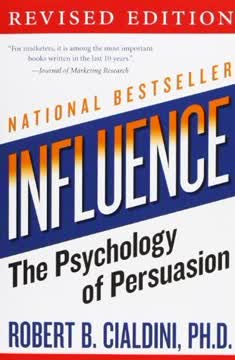Key Takeaways
1. Build rapport through mirroring and genuine interest
"Rapport can be defined as being "in sync" with another person."
Mirror subtly. To build rapport quickly, subtly match the other person's body language, vocal tone, and speech patterns. This creates an unconscious sense of similarity and comfort. However, be careful not to mimic exactly or it will seem unnatural.
Show genuine interest. Ask questions about the other person's interests, experiences, and perspectives. Listen attentively and remember details to reference later. Find common ground to discuss. When you demonstrate authentic curiosity about someone, they will be more inclined to like and trust you.
Match content and process. Align your communication style with theirs, whether they prefer visual, auditory, or kinesthetic language. Match their energy level and conversation pace. By adapting to their preferred style, you make it easier for them to connect with you.
2. Use powerful words and questions to direct thinking
"Words are powerful. Words can set you free and make every experience in life rich and vibrant."
Leverage impactful words. Some of the most persuasive words in English include: you, money, save, results, health, easy, love, discovery, proven, new, safety, guarantee. Use these strategically in your communication to grab attention and emphasize key points.
Ask purposeful questions. Questions direct the other person's thinking and involve them in the process. Use them to:
- Break preoccupation and get attention
- Put the listener on the defensive
- Sustain interest in your subject
- Bring objections into the open
- Lead listeners toward your desired conclusion
- Give listeners credit for the thinking
Frame with intention. How you phrase things impacts how they are perceived. For example, "72% of people chose the 'sure thing' over the 'risky gamble'" versus "28% of people chose the 'risky gamble' over the 'sure thing'" can lead to different interpretations of the same data.
3. Create a sense of scarcity and social proof
"When we find out that something we want is limited in quantity, time, color, or options, our desire for it increases."
Highlight limited availability. Emphasize when products, offers, or opportunities are in short supply or only available for a limited time. This triggers a fear of missing out and increases perceived value.
Showcase popularity. Demonstrate that others, especially those similar to your target, have already chosen your product or idea. Use testimonials, case studies, and statistics to prove widespread adoption.
- "9 out of 10 dentists recommend..."
- "Join over 1 million satisfied customers"
- "The #1 best-selling product in its category"
Create exclusivity. Position your offer as something special or restricted to a select group. This appeals to people's desire to feel unique and part of an elite community.
4. Tell stories that captivate and persuade
"Stories can captivate to the point where you are experiencing everything as if you were there with the storyteller."
Craft compelling narratives. Use stories to make your points more memorable, relatable, and emotionally impactful. A well-told story can bypass logical resistance and connect directly with the listener's emotions and experiences.
Elements of persuasive stories:
- Clear purpose and intention
- Vivid sensory details
- Relatable characters and situations
- Embedded lessons or key takeaways
- A balance of emotion and information
- Quotes and first-person perspective
- Specific details (names, dates, places) for credibility
Practice delivery. Pay attention to pacing, tone, and emphasis. Use pauses for dramatic effect. Adjust your delivery based on audience feedback to maintain engagement.
5. Appeal to emotions first, then justify with logic
"People decide emotionally, then justify with facts."
Identify core emotions. Understand which emotions (fear, hope, pride, etc.) are most relevant to your audience and the decision at hand. Craft your message to resonate with these feelings.
Create emotional connection. Use vivid language, stories, and imagery to evoke the desired emotional response. Help the audience visualize and feel the benefits or consequences of their choices.
Follow with rational support. Once you've engaged emotions, provide logical reasons, data, and evidence to support your position. This allows people to feel good about their emotional decision while satisfying their need for rational justification.
Key emotions to leverage:
- Fear of loss or pain
- Desire for gain or pleasure
- Sense of belonging or exclusivity
- Pride and self-esteem
- Curiosity and novelty
6. Develop a focused outcome mindset
"Success is the result of your single-minded focus on what you want."
Clarify your goals. Be crystal clear about exactly what outcome you want to achieve in any given situation. Visualize the end result in detail.
Maintain focus. Constantly remind yourself of your ultimate objective. Avoid distractions and stay committed to your goal, even when faced with obstacles or setbacks.
Plan strategically. Work backwards from your desired outcome to determine the necessary steps and milestones. Anticipate potential challenges and prepare contingency plans.
Key elements of a focused outcome mindset:
- Clear vision of success
- Unwavering commitment
- Proactive planning
- Resilience in the face of obstacles
- Continuous self-improvement
7. Employ covert persuasion tactics ethically
"The persuasion techniques in this book are designed to be used ethically."
Respect autonomy. While using covert techniques, always ensure that the other person maintains their freedom of choice. Your goal is to influence, not manipulate or coerce.
Aim for mutual benefit. Seek outcomes that are genuinely beneficial for both parties. Don't use these techniques to take advantage of others or promote harmful choices.
Be transparent when appropriate. In certain contexts, especially professional or formal settings, it may be necessary to be more explicit about your intentions and methods.
Ethical guidelines for covert persuasion:
- Do no harm
- Respect individual rights and dignity
- Be truthful in your communication
- Consider long-term consequences
- Use your influence responsibly
8. Understand and leverage human psychology
"People are not logical or rational when they make decisions; they are irrational!"
Recognize cognitive biases. Understand common psychological tendencies that influence decision-making, such as:
- Confirmation bias: Seeking information that supports existing beliefs
- Availability heuristic: Overestimating the importance of easily recalled information
- Loss aversion: Preferring to avoid losses over acquiring equivalent gains
- Anchoring effect: Relying too heavily on the first piece of information encountered
Leverage social proof. People tend to follow the actions of others, especially in uncertain situations. Demonstrate that others have already adopted your idea or product.
Use reciprocity. When you do something for someone, they feel obligated to reciprocate. Offer value first to create a sense of indebtedness.
Frame choices effectively. How options are presented can significantly impact decisions. Consider using contrast, scarcity, or positive framing to influence perceptions.
9. Master the art of asking questions
"Questions are so powerful they deserve an entire book by themselves."
Ask with purpose. Every question should have a clear intention, whether to gather information, challenge assumptions, or guide thinking in a specific direction.
Types of powerful questions:
- Open-ended: Encourage detailed responses
- Closed-ended: Confirm specific information
- Probing: Delve deeper into a topic
- Leading: Guide towards a particular conclusion
- Hypothetical: Explore potential scenarios
Listen actively. Pay close attention to responses and ask follow-up questions. Show genuine interest in understanding the other person's perspective.
Use questions to:
- Build rapport
- Uncover needs and motivations
- Challenge assumptions
- Guide thinking
- Overcome objections
- Close deals
10. Overcome objections and resistance skillfully
"Covert Persuasion is about bypassing the critical factor of the human mind without the process being known to the receiver of the message."
Anticipate objections. Identify potential concerns or resistance points in advance. Prepare thoughtful responses and incorporate them proactively into your presentation.
Use indirect approaches. Instead of directly confronting objections, use stories, analogies, or hypothetical scenarios to address concerns indirectly.
Reframe perspectives. Help the other person see the situation from a different angle. Use questions to guide their thinking towards a new understanding.
Techniques for overcoming resistance:
- Acknowledge and validate concerns
- Find common ground
- Use the "feel, felt, found" technique
- Provide social proof
- Offer risk reversal or guarantees
- Create a sense of scarcity or urgency
Last updated:
FAQ
1. What is "Covert Persuasion: Psychological Tactics and Tricks to Win the Game" by Kevin Hogan about?
- Focus on Hidden Persuasion: The book explores psychological tactics and subtle strategies to influence others without their conscious awareness.
- Research-Based Techniques: It synthesizes findings from psychology, sales, NLP, and communication to present actionable persuasion methods.
- Practical Application: The content is designed for use in business, sales, and personal life, aiming to help readers get more of what they want.
- Ethical Emphasis: The authors stress that these techniques should be used ethically, for mutual benefit rather than manipulation.
2. Why should I read "Covert Persuasion" by Kevin Hogan and James Speakman?
- Gain Persuasion Mastery: The book promises to elevate your persuasion skills to an expert level, making you more effective in influencing others.
- Real-World Results: Techniques are presented as proven to double or triple sales and improve negotiation outcomes.
- Understand Human Behavior: It provides insights into why people say "no," how beliefs are formed, and how decisions are made.
- Versatile Use: Whether you’re in sales, management, or just want to improve personal relationships, the book offers tools for all contexts.
3. What are the key takeaways from "Covert Persuasion"?
- Covert vs. Overt Persuasion: True influence often happens below the surface, bypassing conscious resistance.
- The Power of Questions: Asking the right questions is more persuasive than making statements.
- Emotional Drivers: People make decisions emotionally first, then justify with logic.
- Consistency and Commitment: Getting people to make small commitments increases the likelihood of larger compliance later.
- The Importance of Rapport: Building trust and similarity is foundational to successful persuasion.
4. What are the main covert persuasion techniques described in "Covert Persuasion"?
- Rapport Building: Techniques like mirroring, matching, and finding common ground to create trust.
- Hypnotic Language Patterns: Using presuppositions, embedded commands, and leading questions to guide thinking.
- Scarcity and Social Proof: Leveraging limited availability and the actions of others to increase desire.
- Storytelling: Using stories with specific structure and intention to influence beliefs and emotions.
- Inoculation: Preparing people for objections or outside influence to reduce buyer’s remorse and resistance.
5. How does "Covert Persuasion" define and use the concept of "covert" influence?
- Hidden Influence: "Covert" means persuasion that is concealed, subtle, and not obvious to the target.
- Bypassing Critical Factor: The goal is to bypass the conscious mind’s resistance and reach the subconscious.
- State Management: Techniques often involve changing the emotional or mental state of the target without their awareness.
- Ethical Use: The authors emphasize that covert persuasion should be used for positive, ethical outcomes.
6. What is the "Eight Steps to Get Your Outcome" model in "Covert Persuasion"?
- Identify the Problem: Start by clarifying the issue your target wants to solve.
- Trigger Pain First: Emphasize the cost of not solving the problem before presenting solutions.
- Define Preferred Outcome: Have the target articulate what they want instead.
- Explore Consequences: Get them to imagine the benefits of the new outcome.
- Confirm Authenticity: Ensure the new outcome is genuinely desired.
- Ensure Good Fit: Make sure your solution truly benefits the target.
- Avoid Judgment: Don’t criticize their current choices; seek understanding.
- Never Say They’re Wrong: Avoid making the target defensive by telling them they’re mistaken.
7. How does "Covert Persuasion" explain why people say "no" and how to overcome it?
- Instant Reaction: "No" is often a reflex, not a reasoned decision.
- Memory Bias: People remember peak negative experiences and how things end, influencing future decisions.
- Fear of the Unknown: Ambiguity about the future leads to resistance.
- Overcoming "No": Address past pain, clarify future benefits, and guide the target to visualize positive outcomes.
8. What are the most persuasive words and language patterns according to "Covert Persuasion"?
- Top Persuasive Words: "You," "Money," "Save," "Results," "Health," "Easy," "Love," "Discovery," "Proven," "New," "Safety," "Guarantee."
- Power of "Because": Using "because" in requests increases compliance, even if the reason is trivial.
- Hypnotic Patterns: Phrases like "Would you like to…," "Imagine if…," "Some people…," and "If you could have…" are used to direct thinking.
- Transformational Vocabulary: The words you use shape emotions and outcomes, both for yourself and others.
9. How does "Covert Persuasion" recommend using stories to influence others?
- 20 Keys to Storytelling: The book provides a detailed framework for crafting persuasive stories.
- Intention and Purpose: Every story should have a clear goal and emotional impact.
- Relatability: Stories should be relatable, with vivid details and emotional resonance.
- Embedded Lessons: Use stories to subtly teach, inspire, and lead the listener to your desired conclusion.
10. What role do questions play in the "Covert Persuasion" method?
- Directing Thought: Questions guide the target’s thinking more effectively than statements.
- Ownership of Ideas: People are more likely to act on ideas they believe are their own, which questions facilitate.
- Emotional Engagement: Well-timed, emotionally charged questions increase attention and compliance.
- Control of Conversation: The person asking questions controls the direction and outcome of the interaction.
11. What are the ethical considerations discussed in "Covert Persuasion"?
- Use for Good: The authors stress that these techniques should be used to benefit both parties, not manipulate or harm.
- Leave Others Better Off: The goal is for the target to be in the same or a better position after the interaction.
- Transparency vs. Manipulation: While the methods are covert, the intent should be positive and not exploitative.
- Self-Reflection: Practitioners are encouraged to continually assess their motives and the impact of their influence.
12. What are the best quotes from "Covert Persuasion" and what do they mean?
- "Life IS persuasion!" – Everything you achieve involves influencing others; persuasion is a fundamental life skill.
- "People don’t know why they say 'no.' They don’t know why they do what they do." – Human behavior is often unconscious and irrational, which is why covert techniques work.
- "People make decisions emotionally first, then justify with fact." – Emotional triggers are more powerful than logical arguments in decision-making.
- "Never tell your target person he is wrong." – Direct confrontation increases resistance; agreement and understanding open the door to influence.
- "The words you say become the feelings you feel." – Language shapes both your own and others’ emotional states, making word choice critical in persuasion.
Review Summary
Covert Persuasion receives mixed reviews, with an average rating of 3.60 out of 5. Some readers find it informative and packed with useful techniques for persuasion, particularly in sales and marketing. Others criticize its repetitive content, self-promotion, and lack of depth. The book is praised for its practical tips on communication and influence but criticized for being too focused on salespeople. Some readers appreciate its psychological insights, while others find it lacks substance and scientific backing.
Similar Books









Download PDF
Download EPUB
.epub digital book format is ideal for reading ebooks on phones, tablets, and e-readers.





